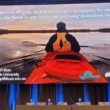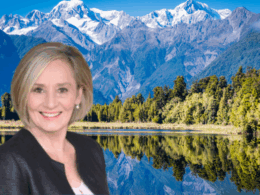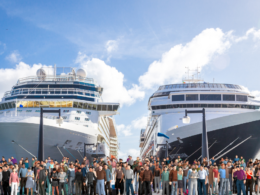Last week the New Zealand government unveiled its Tourism Growth Roadmap which aims to supercharge tourism arrivals to New Zealand. So what investments in infrastructure and protections for environments and communities are in place to sustainably manage supercharged growth?
TRANSCRIPT
The New Zealand government has released its Tourism Growth Roadmap and is lauding its strategy to fast track a return to pre-COVID 19 international arrivals. The focus on growth will come as no surprise. This government has a single-minded growth focus and is unapologetic about that. The hand break is off. The government has set ambitious targets and wants tourism to be at the forefront of economic growth in New Zealand.
Following the release of the government’s Tourism Growth Roadmap last week I was invited to contribute to a short piece for The Conversation which was published online yesterday. The article was written with my Massey and Griffith colleagues Regina and Susanne and is referenced at the end of this podcast transcript. It asks the question: Supercharged or short-sighted?
In The Conversation piece we note that the New Zealand government wants to ‘turbocharge’ the tourism sector with an additional $13.5 million devoted to tourism marketing this year. The intention is that this will help to double tourism value by 2034. The growth roadmap is supported by a Tourism Boost Package.
The Tourism Boost Package includes a $20 million International Visitor Levy (IVL) investment in 2024-2025 of which 100% will be invested in boosting demand through a targeted Australia marketing campaign, a $3 million boost in regional marketing, $3 million for business events and $13.2 million for international marketing. A further $35 million IVL investment will occur in 2025-2026 of which 80% will be invested in boosting demand. $13.5 million will be directed to core markets, $6 million to emerging markets, and $8 million for more business events and major events. In that round of funding $4 million will be invested in the Milford Road corridor improvements and $3.4 million for projects yet to be announced.
The immediate aim is a return to 3.89 million international visitors by 2026 and then onwards and upwards to 4.78 million visitors by 2030 or soon thereafter.
The launch of these strategy and investment documents coincided with Prime Minister Luxon’s visit to China with Tourism Minister, Louise Upston, and the chair of Air New Zealand, Dame Therese Walsh, leading the 28-strong business delegation. There is no secret that attracting Chinese tourists is part of the plan to increase overall tourist arrivals to New Zealand, including in the off-season. As Upston says, ’…we welcome anyone, from anywhere, anytime’.
Ironically the release of the Roadmap also coincided with unprecedented, organised protests against mass tourism across southern Europe last week. Residents of popular cities and islands across Italy, Portugal and Spain are fed up with ‘touristification’, manifesting in overcrowding, damage to natural and cultural sites, and rental hikes, with some taking direct action against tourist by spraying them with water pistols during the protests. The protesters across these countries have vowed to continue their protests until governments begin to listen to, acknowledge and act upon community concerns.
It seems that the New Zealand government is happy to ignore these international signals, and turn a blind eye to what is happening elsewhere in the world. The more blunt critics would argue that the current strategy is completed at odds with what we know is important in managing tourism, and is putting a sustainable tourism future in New Zealand at risk.
Personally I am reminded of the 1990s. In 1992 New Zealand received 1 million international visitors in a year for the first time. The then national government’s tourism minister was Murray McCully and it was decided that New Zealand would adopt an aggressive tourism marketing focus aimed at attracting 3 million visitors a year by 2000. Most observers at the time thought that this would put New Zealand at risk of serious environmental and social impacts.
Even some members of the New Zealand Tourism Board (NZTB) – the forerunner of Tourism New Zealand – were sufficiently uneasy about this political imperative to actually step down from the board. In the early 1990s DOC and NZTB had formed a useful collaboration to managing tourism marketing and visitor experiences in the conservation estate. That promising collaboration was short lived when the focus shifted to unrestrained tourism growth. Five years later a study by the Parliamentary Commissioner in 1997 showed increasing concerns for the social and environmental impacts of high growth tourism.
One thing that we learned in the 1990s was that tourism growth can not be pursued without investing in the industry; whether it be in workforce training, public facilities, community infrastructure and, of course, conservation and protecting the iconic natural areas that tourists ‘must see’ when they visit. You simply can not invest in visitor marketing while ignoring visitor management. We have known this now for a very long time.
So here are some observations of this strategy that we offer in The Conversation piece.
First, supercharging tourism aims most immediately at returning to pre-COVID levels of international visitor arrivals, by next year. This ignores the fact that before the COVID-19 pandemic, there were serious concerns that tourism was causing environmental degradation, crowding and congestion, resulting in declining public support for tourism. As in 1997, this was documented in detail in research released by the Office of the Parliamentary Commissioner in December 2019, immediately prior to COVID-19.
It also ignores the fact that tourism has already exceeded pre-COVID levels in our most popular and most under pressure tourism destinations.
Supercharging tourism also completely ignores the significant investment in the Tourism Futures Taskforce report and Aotearoa Circle Tourism Adaptation Roadmap, which were widely acknowledged for their vision and ambition to create a future tourism that served the aspirations of mana whenua and local communities.
These strategies were developed during the COVID-19 pause when there was across the board support for “building back better”. Essentially a commitment to doing things differently and managing growth responsibly. In other words, being a world leader in sustainable tourism in the 21st century. Many industry leaders were absolutely adamant that this was the ultimate priority for tourism after COVID. This government seems to have missed the memo.
Second, after COVID the then government invested heavily in supporting the development of Destination Management Plans with financial support from the IVL. These DMPs were intended to provide roadmaps for regional tourism development and management – they are visionary regional strategies.
The work of the Tourism Future’s Taskforce, and the DMPs now seem to have been abandoned — disabled by a lack of funding and support from MBIE needed to actually implement the DMPs. Instead District Councils have been left to try to find resources to manage tourism in their regions. The Supercharge Tourism strategy marks a U-turn from destination ‘management’ to ‘marketing’ which leaves all the significant responsibility of managing tourism to regional councils that lack resourcing and support.
Third, the use of the IVL, which was raised to $100 on 1 October 2024, for marketing, is blatantly at odds with its stated purpose. According to New Zealand Immigration “The IVL is your contribution to maintaining the facilities and natural environment you will use and enjoy during your stay”. This is what visitors are advised when they are required to pay the $100 levy when they apply for a visitors visa online.
The diversion of IVL income to fund Tourism Growth Strategy marketing campaigns and business events is a misuse of revenue that was strategically intended to support tourism regions to protect their natural environment and maintain critical infrastructure. New Zealand Immigration should update its website without delay, because currently it is now providing very misleading information on the levy that visitors are being required to pay.
It is ironic that Australian visitors, New Zealand’s largest international visitor market, is exempt from the IVL. So we have a situation when international visitors are paying a levy that is sold as a contribution to sustainable tourism management, but is in fact now being used in part to fund marketing New Zealand to Australians, who do not have to pay the levy.
Of course this strategy could also backfire with visitors who are encouraged to respect New Zealand’s unique environment through the Tiaki Promise, and whose expectation of the IVL is to support a mechanism that ‘gives back’ to managing the destination.
Related to this, there are several practical flaws with the current government’s growth-at-all-costs approach to economic development. Firstly, human resource and infrastructure limitations cannot accommodate these rates of growth. The acting mayor of MacKenzie District said when interviewed on RNZ that last summer, several businesses around Tekapo were forced to operate below capacity because there was no local housing available for the staff they needed: only up-market holiday rentals were available.
And we are facing a tourism workforce crisis. Over the past 10 years there has been a 63% drop in the number of students in tourism-related courses, and a 73% decrease in those completing hospitality courses. That makes rebuilding the tourism workforce, so depleted during COVID-19, an impossible task without some sort of government strategy and support.
Meanwhile basic utilities such as electricity and drinking water are being stretched beyond carrying capacity during peak visitation times in destinations across the motu.
Fourth, we risk environmental damage and compromising the appeal of NZ’s most iconic attractions. The growing visitor pressures of mass tourism at Piopiotahi Milford Sound occurred in the face of sustained high tourism growth in the mid-2010s, long before COVID. The Milford Opportunities Group was established to rethink access to Piopiotahi and future-proof tourism in accordance with UNESCO World Heritage status due to its outstanding natural and cultural values.
However, on 4 June the government rejected the Milford Opportunities masterplan which had proposed a range of interventions to manage tourism access by road, air and sea, and limit tourism impacts. The Tourism Minister tried to argue that unregulated and unmanaged access by road, fixed wing aircraft and cruise ships would disperse visitor access pressures and allow tourist access to Piopiotahi to be maximised. Unless it is revived by a future government, this will surely become known as the Milford Missed-Opportunities Project.
Fifth, we are at risk of tourism losing its social licence, as in Europe, if we are more concerned about tourist numbers than quality tourism. Tourism places huge burdens on regional communities. As the Mayor of Queenstown noted recently: “When I first started as the mayor, I think it was one resident night to every 30 visitor nights. It is now one to 47′′.
We cannot continue to show indifference to the concerns of people who live in destination communities. The current protests in Europe are already reflected in local protests against cruise ships in some port communities in New Zealand. Media coverage of protests in Europe will no doubt embolden communities elsewhere, including New Zealand, where frustrations with mass tourism are building.
****
Widespread scepticism has been expressed that the New Zealand government’s tourism strategy is in fact altogether lacking in strategy. What we need is a carefully considered long-term tourism strategy that is free of short-term political interests.
Some observers – myself included – have argued the need for a national Tourism Commissions to give short, medium and long-term direction to an industry that is currently in a constant state of confusion. I spoke about this at length in my podcast on 24 October last year, drawing on insights that Glenys Coughlan presented in the Tourism Policy School in Queenstown.
A Tourism Commission would involve both the public and private sector and would provide coordination and focus to guide and invest in tourism development to meet the challenges that the industry is increasingly required to confront. It could be modelled on the enormously successful Ireland and Scotland’s National Tourism Development Authorities – Failte Ireland and Visit Scotland.
They provide a coordinated approach to tourism development interests and priorities through a wide range of high-level responsibilities. These include:
- Overseeing development priorities including tourism climate action programmes, tourism product development, education and career development and regional development strategies;
- Overseeing registration and grading, including national quality assurance frameworks and managing short-term tourist letting registers;
- Coordinating national and regional marketing, including regional experience brands, and
- Managing funding programmes, coordinating tourism data management and research and managing research archives so that we learn rather than repeat mistakes from the past.
All of these things should be done in a manner that brings together the wide-ranging interests of this unique and disparate industry. This would provide a platform for identifying the opportunities presented by tourism, but also responding to the sustainability challenges that we face – which were so comprehensively addressed by the Tourism Future’s Taskforce.
In the case of New Zealand, a Tourism Commission might also provide a strong and unifying voice on Fast Track proposals, such as developing a gold mine in Central Otago, which poses an enormous threat to the future of tourism in this key region.
****
Tourism needs to be freed from the political whims of the day. This constant flip-flopping of tourism policy priorities must leave regional destinations in a state of constant frustration. We also need to be relieved of the revolving door or tourism ministers who seem to know little or nothing about the industry when they take up the portfolio, and who generally lack awareness of lessons learned the hard way in recent decades, and recent years.
We know that long-term value creation through tourism can only happen when assets are looked after, and when ‘value’ is defined in ways that deliver to all stakeholders, including businesses, visitors, mana whenua and local communities.
By contrast, this government’s single-minded focus on tourism growth comes with disregard for sustainable tourism policy. This will undermine the future wealth and wellbeing of all, including nature, in this country. Its obsession with growth comes with an abandonment of regional tourism planning that is alarming, and an apparent disregard of local community concerns. Moving forward constructively will require the regions to wrestle tourism interests back from the grips of see-sawing, short-term political agendas.
This podcast is informed by The Conversation piece (23 June 2025) referenced below, which has been elaborated in ways that reflect my own personal opinions.
References
- Scheyvens, R., Higham, J.E.S. & Becken, S. (2024). Super charged or short sighted? Tourism’s troubled turn in New Zealand. The Conversation (23 June 2025).
- Tourism Growth Roadmap (2025). Ministry of Business, Innovation and Employment. https://www.mbie.govt.nz/immigration-and-tourism/tourism/tourism-growth-roadmap
- Parliamentary Commissioner for the Environment (2019). Pristine, popular… imperilled? The environmental consequence of tourism growth. December 2019. https://pce.parliament.nz/publications/pristine-popular-imperilled-the-environmental-consequences-of-projected-tourism-growth/
- Tourism Futures Taskforce (2020). We are Aotearoa. Ministry of Business, Innovation and Employment (MBIE). December 2020. https://www.mbie.govt.nz/assets/the-tourism-futures-taskforce-interim-report-december-2020.pdf
- The Aotearoa Circle (2023). Tourism Adaptation Roadmap (May 2023). https://www.theaotearoacircle.nz/tourism-adaptation-roadmap








